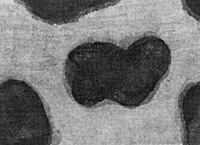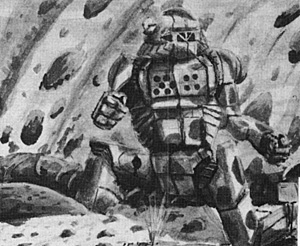
Desert Camo
Rocky wastelands and flat expanses of brush, deserts are the most common land form in the Inner Sphere. As such, they often become the battlefields for the armies of the Successor States.
Pattern for Desert Camo #2
The Desert Camouflage Pattern #2 is the scheme most widely used by units operating in rough ground and dry savannah. Though the use of camouflage in such locations may seem of limited value, it can prove surprisingly effective.
Worlds and Environments
Many planets, due to solar position or small size, consist entirely of this harsh climate. More hospitable planets normally have deserts along their equatorial regions, and even most wet worlds will have at least one area that receives little moisture. In such arid lands, vegetation is either thin or nonexistent, leaving a windswept terrain of low brush, rock, and eroded ravine.
While discussing every desert environment in the Inner Sphere may well be impossible, a sampling of the wide variety of worlds are described below.
Hesperus II
Known throughout the Inner Sphere for its large BattleMech factories, Hesperus II has been repeatedly attacked and raided for nearly six centuries. While the battle have destroyed much of the planet's surface. the massive facility remains the Federated Commonwealth's single largest producer of BattleMechs. The main reason for the planet's continued survival has been the world's dry, planet-wide mountains.
The contorted landscape of the Myoo Mountain range - into which Defiance Industries is build - makes large-scale attacks practically impossible, while the scarcity of passes through which 'Mechs can travel restricts access to the factories. The mountains themselves have been known to cause casualties when 'Mechs have lost their footing on the treacherous slopes.
The Defiance Self-Protection Force and regular units stationed on Hesperus II paint their vehicles in Desert Camo #2. Tan and dark brown colors are used to blend in with the granite mountains of the surrounding areas. 'Mechs serving in the few lowland deserts sport a variant scheme that uses horizontal "tiger stripes" in a lighter brown color.
Baker III
Small and cold, Baker III is the only marginally terrestrial planet in a system populated by gas giants. Its twin domed cities house a modest population that serves the 'Mech garrison and the administrative headquarters for a dozen orbital stations that mine the 'jovian' planets. Its location, over 58 parsecs from the old Kurita border, has spared the system from much of the devastation of the Succession Wars. The coming of the Clans, however, has put the Baker system on the front lines and in the direct path of the invading forces.
The planet's thin carbon dioxide atmosphere gives the surface a distinctly orange hue. A red and orange Desert Camo #2 is the most effective pattern for 'Mechs serving on Baker III's rocky wastes.
Al Hillah
Beneath a blazing type A7 star, the Azami world of Al Hillah is a true desert planet. Completely uninhabitable at the equator without life support, the poles are the only places that the hardiest of plant life can survive. Sunlight at the temperate zones is just barely tolerable to the unprotected human eye.
During the War of 3039, Al Hillah served as a staging base for Kurita's counteroffensive into the Lyran half of the Federated Commonwealth. Since the subsequent peace treaty with both major powers, units stationed on Al Hillah have seen little action.
The odd pattern of gloss white and light sand paint is applied as camouflage to vehicles operating in Al Hillah's sandy deserts. Among dazzling silicate dunes, an unmoving BattleMech can remain undetected until its target is well within effective weapons range.
Thessalonika
Deep within the interior of the Draconis Combine, Thessalonika III is a world with minimal agricultural or industrial resources. Only a minor axial tilt and extensive natural underground aquifers givethe planet large tracts of semi-arid plain that maintain herd of grazing animals. Its newfound importance is as the jump-off point for raids against Clanoccupied Rasalhague planets.
During the winter-spring of 3051, Kurita units have conducted a dozen raids against Clan targets. On one occasion in April, elements of the Ghost Bear Clan traced the raiders back to Thessalonika and conducted a counter-strike. The Clan 'Mechs grounded in the savannah outside the capital city of Tyrsis and proceeded to attack a local air base. The local garrison - including the original raiding party - forced the Clan 'Mechs off planet after the attackers succeeded in destroying a lance of aerospace fighters and crippling the base's facilities.
 Javelin in the Foothills of the Myoo Mtns, Painted In Desert Camo #2
Javelin in the Foothills of the Myoo Mtns, Painted In Desert Camo #2
BattleMechs serving on Thessalonika III typically use a Desert Camo # 2 painted with tan and drab green. While not providing in the way of closeup concealment, this pattern will blend a 'Mech's outline with the low brush and grass of a rolling plain.
The Desert Camouflage Pattern
Desert camouflage, unlike schemes designed for vegetation, uses a simple two-tone pattern. The lighter color is laid down as a base, the darker color is applied. In rocky or brush covered areas, random irregular spots are most effective. Mountainous and open desert regions use short horizontal stripes to blend in with the natural lines of the terrain. It is important to keep the pattern uncluttered; a general rule of thumb is to have the secondary coat cover not more than 50% of the vehicle. Any more may make the overall tone darker than the surrounding terrain, contrasting the vehicle against its background and destroying the effect of the camouflage.
Even on the same planet, desert regions can be distinct enough from one another to reduce the effectiveness of camouflage when a unit is forced to move into a different area. For this reason, units expecting to fight a highly mobile campaign will paint their vehicles with colors that are partially useful in all expected areas of operation.
A commander who can effectively utilize camouflage has any number of advantageous tactics open to him. Properly camouflaged, a dug-in 'Mech of rank can remain nearly invisible, even on seemingly barren terrain. The pattern also provides and additional advantage when detected. Even on the move, the random dark areas will break up and disrupt a 'Mechs' silhouette as it advances across the battlefield.
Back to BattleTechnology 17 Table of Contents
Back to BattleTechnology List of Issues
Back to MagWeb Magazine List
© Copyright 1992 by Pacific Rim Publishing.
This article appears in MagWeb.com (Magazine Web) on the Internet World Wide Web.
Other military history articles and gaming articles are available at http://www.magweb.com